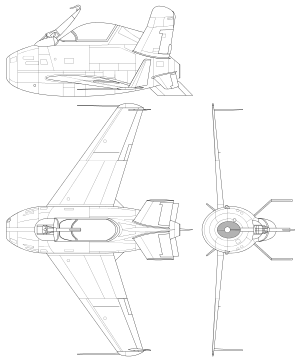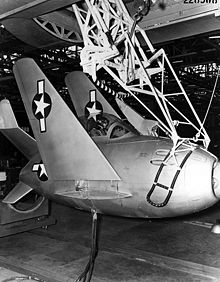McDonnell XF-85
| McDonnell XF-85 Goblin | |
|---|---|
 Early XF-85 without the winglets of the later test series |
|
| Type: | Experimental airplane |
| Design country: | |
| Manufacturer: | |
| First flight: |
August 23, 1948 |
| Commissioning: |
Flight tests canceled in 1949 |
| Production time: |
Was never mass-produced |
| Number of pieces: |
3 |
The McDonnell XF-85 Goblin (German: Kobold ) was an American experimental aircraft . As a parasite fighter , it had been specially designed to operate from the Convair B-36 long-range bomber . The idea was to carry the compact jet aircraft in the bomb bay of the B-36 and to take off in the air in the event of an attack by enemy fighters. After the mission, it should be picked up again by the carrier aircraft. However, there was no series production.
history
In the 1940s there were considerations as to how one could provide effective escorts for the B-36. The range of the heavy bomber was far too high to be escorted by escort fighters all the way , since at that time the possibilities for air refueling were not yet developed.

It was decided to develop a parasite fighter. This concept has already been successful in the 1930s in the United States with Curtiss F9C - biplanes and airships have been used as a carrier. The idea of docking on a fixed-wing aircraft was not new either. At the time of the US airships, there were already successful missions in the Sweno project in the former Soviet Union with up to five fighters / fighter bombers docked on a carrier aircraft. The basic principle of having the fighter coupled to a trapeze while in the air and then using this trapeze to retract and extend the carrier aircraft should be used again. So the new aircraft had to be built compactly and equipped with retractable wings .
In March 1947, the McDonnell Aircraft Corporation received the order to build two test aircraft under the designation XP-85 for the US Air Force . Furthermore, devices and the necessary modifications to the B-36 should be worked out in order to carry an XP-85 in addition to the usual bomb load. Alternatively, there was also a wish to include three XP-85s and no bomb load.
The result was a compact jet aircraft with conventionally swept wings. Three small rudders formed a kind of "W" at the stern. The "Goblin" did not have its own landing gear, but the pilot had the option of getting out of the car with an ejector seat in an emergency . For later series production there was the option of installing four .50 caliber machine guns .
In the course of a designation reform of the US Air Force, from 1948 onwards, all hunters no longer received a "P" (for pursuit: pursuit) as an identification letter, but an "F" (fighter, analogously: fighter aircraft). The "Goblin" was also renamed XF-85; however, the original name XP-85 can still be found in various publications to this day.
The first prototype (serial number: 46-523) was damaged in wind tunnel tests . The first flight was carried out on August 23, 1948 with the second machine (46-524). A B-29B-65-BA (44-84111), specially converted and therefore designated as the EB-29B, served as the carrier aircraft during the test . The first tests only included retracting and extending the bomber and unfolding the wings. The real first flight followed on August 28: the XF-85 detached itself from the carrier and flew free for about 15 minutes. When attempting to dock again, the light aircraft got into turbulence caused by the bomber. The pilot tried in vain for 10 minutes to latch on until the holding trapezoid smashed the cockpit canopy. The "Goblin" performed a belly landing on Edwards Air Force Base (then still "Muroc Army Air Force Base"). The pilot survived unharmed.
The machine was repaired and three more flights showed that this turbulence made coupling to the bomber difficult; but during these flights the maneuver succeeded. On the fifth test flight, however, an aerodynamic fairing was missing on the docking trapeze. The turbulence was so strong that the XF-85 got completely out of control and had to make another emergency landing. To increase stability, the machine was provided with small vertical surfaces at the tips of the wings ( winglet ) and on April 8, 1949, the Luftwaffe even sent the repaired first prototype on its first and only flight. As a result, both machines had to be emergency landed again after they got into turbulence during the docking maneuver.
The US Air Force came to the conclusion that these flight maneuvers could not be accomplished by an average trained pilot. In addition, those responsible had doubts about the ability of the XF-85 to really take on a conventional combat aircraft in an emergency, although the pilots involved attested the machine's good flight characteristics. The program was discontinued on October 24, 1949.
The XF-85 was not the last attempt to establish a parasite fighter. Useful insights were gained for the FICON program . To this day, the XF-85 is considered to be the smallest jet-powered fighter ever built. However, according to the Guinness Book of Records, the smallest jet aircraft ever is the Bede BD-5J Microjet .
Whereabouts
The first machine went to the Strategic Air Command Museum in Omaha , the second to the museum at Wright-Patterson Air Force Base in Dayton , Ohio .
Technical specifications
| Parameter | Data |
|---|---|
| length | 4.50 m |
| span | 6.44 m, 1.64 m with folded wings |
| height | 2.50 m |
| Empty weight | 1,696 kg |
| Takeoff weight max. | 2,063 kg |
| crew | 1 |
| Top speed | 1,069 km / h at a low altitude |
| Service ceiling | 15,000 m |
| Range | 320 km |
| Engines | A Westinghouse J34 -WE7 or WE22- jet engine with 13 kN thrust |
See also
literature
- Francis Allen: The Ultimate Escort? - McDonnell XF-85 Goblin . In: AIR Enthusiast Fifty-Two, Winter 1993, pp. 17-23
- Robert F. Dorr: McDonnell XF-85 - The Built-in Fighter (Beyond the Frontiers) . In: Wings of Fame, Volume 7 1997, pp. 26-35
Web links
- XF-85 Fact Sheet (engl.)

